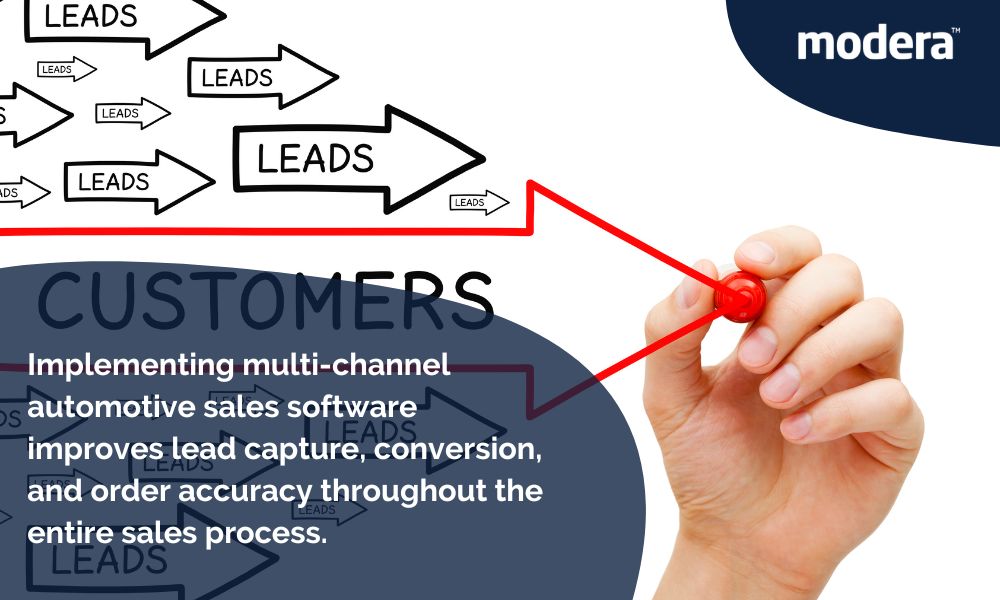
OEMs and automotive importers manage complex networks that span multiple customer touchpoints, regions, and sales systems. Without the right tools, maintaining consistency, visibility, and efficiency becomes nearly impossible. Multi-channel automotive sales software helps centralize operations, allowing you to unify leads, automate workflows, and deliver a seamless sales experience for both your staff and the customers.
What is multi-channel automotive sales software?
Multi-channel automotive sales software is a solution that connects all customer interactions—online, in-showroom, and mobile—within a single, centralized platform. It ensures consistent pricing, messaging, and branding across every sales channel. The software seamlessly integrates with CRM, ERP, dealer systems, and marketplaces to deliver synchronized customer and sales data. Real-time dashboards help teams monitor campaign performance and lead activity across every customer touchpoint.
Why OEMs and importers need it?
OEMs face fragmented systems that slow down response time, reduce transparency, and limit channel-specific insights. Multi-channel automotive sales software addresses these problems by streamlining how you manage leads, inventory, and performance. It eliminates duplicated efforts by integrating dealer systems and third-party platforms into a single user-friendly interface. With a unified view, teams can instantly identify gaps and opportunities in sales pipelines across all regions and channels.
How multi-channel automotive sales software enhances efficiency and sales outcomes
Implementing multi-channel automotive sales software significantly improves lead capture, conversion, and order accuracy throughout your entire sales process. With a centralized platform, sales teams spend less time re-entering data and more time engaging customers. The software automates routine tasks like lead routing, appointment setting, and follow-ups based on lead scores. As a result, conversion rates increase while operational overhead decreases.

You also gain access to live market insights and analytics that reveal channel performance, demand trends, and regional buying behavior. These insights help your team refine targeting strategies, optimize inventory levels, and adjust pricing with real-time precision. With the right automotive sales software, dealers also benefit from synchronized updates on inventory availability, order status, and customer preferences.
Key advantages of using future-ready software
The benefits of adopting multi-channel automotive sales software extend across the entire organization. Sales teams experience faster deal cycles, while marketing teams gain accurate data for campaign optimization. Management gains complete transparency into performance KPIs across online and offline channels. Automation reduces manual errors and ensures all pricing and branding remains consistent across your dealer network.
On top of that, dealer relationships improve, as they can access accurate and timely sales information through a shared system. With mobile compatibility, your field reps can engage customers and update leads directly from the showroom or on the go. Implementing the right software for your business also supports omnichannel experiences, allowing customers to start their journey online and complete it in-person—without friction.
Choosing the right solution
Choosing the right multi-channel automotive sales software begins with mapping out your sales structure and identifying performance bottlenecks. Prioritize platforms that offer robust integration with your existing systems and strong API support. Ensure the software supports mobile functionality, detailed analytics, and automated workflows that match your existing processes.
Scalability should also guide your decision. The right software should adapt to your growing dealer network, expanding inventory, and evolving market demands. It’s essential to evaluate vendor support, training resources, and post-launch assistance when selecting the right partner for implementation.

Best practices for implementation and adoption of multi-channel automotive sales software
Rolling out multi-channel automotive sales software successfully requires a well-structured, phased approach across your dealer and corporate teams. Begin by piloting the solution in a controlled environment, such as a single market or region. Use this stage to fine-tune workflows and gather feedback from end users.
It’s imperative to train your teams thoroughly with hands-on sessions and scenario-based practice. Communicate the business value of multi-channel automotive sales software clearly and consistently to foster early buy-in. Monitor system adoption through KPIs like lead response times and conversion rates, then adjust your rollout plan accordingly.
Measuring success with data-driven KPIs
To evaluate the effectiveness of multi-channel automotive sales software, monitor KPIs tied to efficiency, engagement, and revenue growth. Important metrics include average lead response time, deal closure rates, sales cycle duration, and inventory turnover. Platforms that offer real-time dashboards make it easy to track performance improvements and identify areas for additional optimization.
The software’s analytics tools also help quantify marketing ROI by showing which channels deliver the highest-quality leads and conversion rates. Over time, multi-channel automotive sales software allows OEMs to make better decisions based on concrete data rather than assumptions or incomplete reports.
Future-proofing with advanced capabilities
The best multi-channel automotive sales software platforms continue to evolve, offering cutting-edge tools powered by AI, automation, and machine learning. Look for features like predictive lead scoring, automated chatbots, virtual showrooms, and dynamic pricing engines. These innovations provide new ways to personalize the customer experience and improve lead quality.
There’s no doubt that in the near future augmented reality tools and voice-activated interfaces will play a big role in the buying journey. Multi-channel automotive sales software will integrate these capabilities to support a fully immersive and seamless omnichannel experience for every customer.
Preparing for challenges
While the benefits are clear, adopting multi-channel automotive sales software comes with its share of challenges. User resistance, data migration issues, and integration complexity can slow down deployment. You can mitigate these issues by involving key users early in the process and providing continuous support. Roll out the platform in stages and use small wins to build momentum and buy-in.
It’s also important to plan training around real use cases and offer easy-to-access help resources. The more comfortable your team feels using multi-channel automotive sales software, the faster you’ll see a return on investment.
To sum up
Multi-channel automotive sales software enables OEMs and importers to create more agile, data-driven, and customer-centric sales organizations. It centralizes operations, improves sales performance, and aligns every channel with consistent branding and data. By selecting the right solution and executing a smart rollout strategy, dealerships can future-proof their business and stay ahead of the ever-changing market demands.


